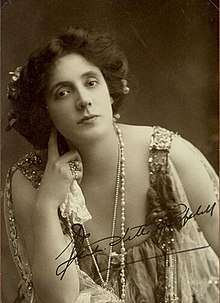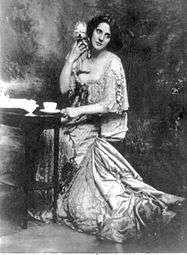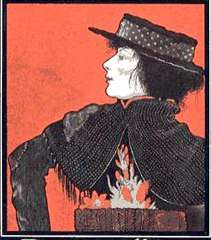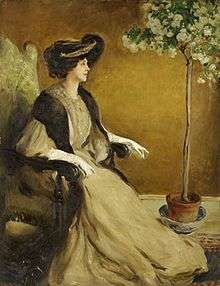Mrs Patrick Campbell
Mrs Patrick Campbell (9 February 1865 – 9 April 1940), born Beatrice Rose Stella Tanner and known informally as "Mrs Pat", was an English stage actress, best known for appearing in plays by Shakespeare, Shaw and Barrie, she also toured the United States and appeared briefly in films.[1]
Mrs Patrick Campbell | |
|---|---|
 | |
| Born | Beatrice Rose Stella Tanner 9 February 1865 Kensington, London, England |
| Died | 9 April 1940 (age 75) Pau, Basses-Pyrénées, France |
| Other names | Mrs Pat |
| Occupation | Actress |
| Years active | 1888–1935 |
| Spouse(s) | Patrick Campbell (1884–1900; his death) George Cornwallis-West (1914–1940; her death) |
Early life and marriages
Campbell was born Beatrice Rose Stella Tanner in Kensington, London, to John Tanner (1829–1895) and Maria Luigia Giovanna ("Louisa Joanna") née Romanini (1836–1908), daughter of Count Angelo Romanini. She studied for a short time at the Guildhall School of Music. In 1884 she eloped with Patrick Campbell, while pregnant with their child, Alan "Beo" Urquhart. Their second child, Stella, was born in 1886. Patrick Campbell went to Australia, and later to South Africa. He died in the Boer War in 1900.[2]
Fourteen years later, Campbell became the second wife of George Cornwallis-West, a writer and soldier previously married to Jennie Jerome, the mother of Sir Winston Churchill. Notwithstanding her second marriage she continued to use the stage name "Mrs Patrick Campbell".[1]
Stage career


Campbell made her professional stage debut in 1888 at the Alexandra Theatre, Liverpool, four years after her marriage to Patrick Campbell. In March 1890, she appeared in London at the Adelphi, where she afterward played again in 1891–93. She became successful after starring in Sir Arthur Wing Pinero's play, The Second Mrs Tanqueray, in 1893, at St. James's Theatre where she also appeared in 1894 in The Masqueraders. As Kate Cloud in John-a-Dreams, produced by Beerbohm Tree at the Haymarket in 1894, she had another success, and again as Agnes in The Notorious Mrs. Ebbsmith at the Garrick (1895).
Among her other performances were those in Fédora (1895), Little Eyolf (1896), and her notable performances with Forbes-Robertson at the Lyceum in London's West End in the rôles of Juliet in Romeo and Juliet, Ophelia in Hamlet, and Lady Macbeth (1895–98) in Macbeth. Once established as a major star, Campbell assisted in the early careers of some noted actors, such as Gerald Du Maurier and George Arliss.[3]
In 1900, "Mrs Pat", having become her own Manager/Director, made her debut performance on Broadway in New York City in Heimat by Hermann Sudermann, a marked success. Subsequent appearances in New York and on tour in the US established her as a major theatrical presence there. Campbell would regularly perform on the New York stage until 1933. Other performances included roles in The Joy of Living (1902), Pelléas et Mélisande (1904; as Melisande to the Pelleas of her friend Sarah Bernhardt), Hedda Gabler (1907), Electra (1908), The Thunderbolt (1908), and Bella Donna (1911).

In 1914, she played Eliza Doolittle in the original West End production of Pygmalion which George Bernard Shaw had expressly written for her.[4][5] Although forty-nine years old when she originated the role opposite the Henry Higgins of Sir Herbert Beerbohm Tree, she triumphed and took the play to New York and on tour in 1915 with the much younger Philip Merivale playing Higgins. She successfully played Eliza again in a 1920 London revival of the play.[6][7]
A couple of "Mrs Pat"'s later significant performances were as the title role in the 1922 West End production of Henrik Ibsen's play Hedda Gabler[8] and Mrs. Alving in the "Ibsen Centennial" (1928) staging of Ghosts (with John Gielgud as her son Oswald).[9] Her last major stage role was in the Broadway production of Ivor Novello's play A Party where she portrayed the cigar-smoking, pekinese wielding actress "Mrs. MacDonald" – a clear takeoff on her own well known persona – and made off with the best reviews. In her later years, Campbell made notable appearances in films, including One More River (1934), Riptide (1934), and Crime and Punishment (1935). Her tendency, however, to reject roles that could have vitally helped her career in later years caused Alexander Woollcott to declare "...she was like a sinking ship firing on the rescuers".[10]
Relationship with George Bernard Shaw
In the late 1890s Campbell first became aware of George Bernard Shaw – the famous and feared dramatic critic for The Saturday Review – who lavishly praised her better performances and thoroughly criticised her lesser efforts. Shaw had already used her as inspiration for some of his plays before their first meeting in 1897 when he unsuccessfully tried to persuade "Mrs Pat" to play the role of Judith Anderson in the first production of his play The Devil's Disciple.[11] Not until 1912, when they began negotiations for the London production of Pygmalion, did Shaw develop an infatuation for "Mrs Pat" that resulted in a passionate, yet unconsummated, love affair of mutual fascination and a legendary exchange of letters.[12] It was Campbell who broke off the relationship [13] although Shaw was about to direct her in Pygmalion. They remained friends in spite of the break-up and her subsequent marriage to George Cornwallis-West, but Shaw never again allowed her to originate any of the roles he had written with her in mind (e.g. Hesione Hushabye (Heartbreak House), the Serpent (Back to Methuselah), etc.).[14] When Anthony Asquith was preparing to produce the 1938 film of Pygmalion, Shaw suggested Campbell for the role of Mrs Higgins but she declined.[15]

In later years, Shaw refused to allow the impoverished Campbell to publish or sell any of their letters except in heavily edited form, for fear of upsetting his wife Charlotte Payne-Townshend and the possible harm that the letters might cause to his public image.[16] Most of the letters were not published until 1952, two years after Shaw's death.
Famous quotes

Campbell was infamous for her sharp wit. Her best-known remark, uttered upon hearing about a male homosexual relationship, was "My dear, I don't care what they do, so long as they don't do it in the street and frighten the horses,"[17] although this remark has been attributed to others as well.
At a dinner in the United States, she was seated next to a scientist who talked incessantly to her about ants. "They even have their own police force and army", he enthused. "No navy?" she replied.[18]
Death
Campbell died on 9 April 1940 in Pau, France, aged 75, of pneumonia.[1] Her death was one of the few deaths of a personal nature that George Bernard Shaw ever noted in his personal diaries.[19]
Legacy
A note book belonging to Campbell is housed at the University of Birmingham Special Collections Department. Several collections of Campbell's correspondence, including her letters to Shaw (MS Thr 372.1), are part of the Harvard Theatre Collection at Houghton Library, Harvard University. A number of her letters and her annotated script for Chester Bailey Fernald's The Moonlight Blossom are in the theatre manuscripts collection of the Harry Ransom Center, University of Texas at Austin. The Ransom Center's collection of Shaw papers includes letters from Campbell, and the library includes a number of Shaw's published works from Campbell's private library.[20]
Family
Her father John Tanner (1829–1895), a descendant of Thomas Tanner, Bishop of St Asaph,[21] was a Consul and merchant who "managed to get through two large fortunes",[22] in part through losses in the Indian Mutiny.
Her mother, Louisa Joanna Romanini, was one of the eight daughters of Angelo Romanini of Brescia and Rosa née Polinelli of Milan. Angelo had joined the Carbonari and, as a result, had to leave Italy. He and his family travelled over Eastern Europe aided by a firman from the Sultan of Turkey. Six of his eight daughters, all under eighteen, married Englishmen.[23]
Her first husband Patrick Campbell (1855–1900) was the son of Patrick McMicken Campbell (1826–1896), a banker who was the Chief Manager of the Oriental Bank Corporation, and his first wife Montgomerie Anne née Kerr (1836–1869). After her death he married her cousin, Alicia Anne Kerr.
Patrick and Beatrice first met at a card party at the house of Mrs Gifford in Dulwich[24] and eloped within four months to marry at St Helen, Bishopsgate.[25] Patrick's health was poor and in 1887 he was ordered by his doctor to take a sea voyage.[26] He was to stay away for six and a half years in Australia and then Mashonaland. He found some work but never sent enough back for Beatrice and the children to live on. When he returned in 1893, she saw that "his health and energies were undermined by fever, failure, and the most bitter disappointments",[27] whereas she was by then a successful actress. In mid-March 1900, Patrick returned to South Africa to join Lord Chesham's Yeomanry. He was killed in a charge at Boshof on 5 April,[28] the same action in which Colonel George de Villebois-Mareuil died.
Their son Alan Urquhart 'Beo' Campbell (1885–1917) became a Naval Cadet in 1898 at HMS Britannia and was about to take his naval entrance exams when his father died in 1900. He left the navy that year and went to Oxford[29] and later worked as an actor. In 1908, on tour with his mother he met Helen Parker Bull (1885–1981).[30] They married in 1909 in Quincy, Illinois, and divorced in 1915. He re-joined the RNVR at the outbreak of war and became a Lieutenant Commander, being awarded the Military Cross and bar.[31] On 30 December 1917 he was killed by a shell while serving in the Royal Naval Division at La Vacquerie on the Cambrai front.
Their daughter Stella (1886-1975)[32] also joined her mother on stage, and toured with her in the USA, but "made up her mind to marry a man [Beatrice] scarcely knew, who had lived in Africa for many years".[33] Stella left for Kenya in early 1911 to marry Mervyn Worcester Howard Beech (1881–1923).[34]
In 1909, Campbell produced His Borrowed Plumes by Lady Randolph Churchill, whose husband, George Cornwallis-West, was "seriously attracted to me".[35] They married on 6 April 1914, the day after the decree absolute of his divorce.[36]
Filmography
| Year | Title | Role | Notes |
|---|---|---|---|
| 1920 | The Money Moon | ||
| 1930 | The Dancers | Aunt Emily | |
| 1934 | Riptide | Aunt Hetty | |
| 1934 | One More River | Lady Mont | |
| 1934 | Outcast Lady | Lady Eve | |
| 1935 | Crime and Punishment | Pawnbroker | (final film role) |
References
Notes
- "Mrs. Campbell, 75, Famous Actress". The New York Times. 11 April 1940. Retrieved 29 June 2008.
Mrs. Patrick Campbell, famous actress, died last night in Pau, according to word received here to day. She had taken leading roles in plays of Shakespeare, Shaw and Barrie, and on several occasions had toured America.
- Aston, Elaine (2004). "Campbell [née Tanner], Beatrice Stella [performing name Mrs Patrick Campbell]". doi:10.1093/ref:odnb/32261. Cite journal requires
|journal=(help) - Peters (1985), pp. 179–181, 183
- Huggett (1969), pp. 20–27
- Peters (1985), p. 307
- Huggett (1969), pp. 183–187
- Peters (1985), pp. 364–367
- Peters (1985), pp. 379–382
- Peters (1985), pp. 397–398
- Peters (1985), pp. 422–425
- Peters (1985), pp. 139–140
- Bernard Shaw and Mrs. Patrick Campbell: Their Correspondence edited by Alan Dent, 1952 Alfred A Knopf
- Peters (1985), pp. 330–333
- Peters (1985), pp. 404–407
- Huggett (1969), pp. 2–3
- Peters (1985), pp. 369–378
- Dent (1961), p. 78
- Great British Wit, Rosemarie Jarski, Ebury Press, 2005
- Peters (1985), p. 462
- "George Bernard Shaw: An Inventory of His Collection at the Harry Ransom Humanities Research Center". norman.hrc.utexas.edu. Retrieved 11 November 2016.
- Campbell (1922), p. 1
- Campbell (1922), p. 2
- Campbell (1922), p. 3
- Campbell (1922), p. 29
- Campbell (1922), p. 35
- Campbell (1922), p. 37
- Campbell (1922), p. 120
- Campbell (1922), p. 192
- Campbell (1922), p. 382
- Campbell (1922), p. 299
- Supplement to the London Gazette (PDF). 13 February 1917. p. 1539.
- "Stella Patrick Campbell". National Portrait Gallery. Retrieved 10 June 2018.
- Campbell (1922), p. 309
- Campbell (1922), p. 311
- Campbell (1922), p. 307
- Campbell (1922), p. 373
Bibliography
- Campbell, Mrs Patrick (1922). My Life and Some Letters. New York: Dodd, Mead and Company. Retrieved 9 October 2016.
- William Archer (1897). The Theatrical World. London.
- Alan Dent, ed. (1952). Bernard Shaw and Mrs. Patrick Campbell: Their Correspondence. Alfred A Knopf.CS1 maint: ref=harv (link)
- This article incorporates text from a publication now in the public domain: Gilman, D. C.; Peck, H. T.; Colby, F. M., eds. (1905). New International Encyclopedia (1st ed.). New York: Dodd, Mead. Missing or empty
|title=(help) - Dent, Alan (1961). Mrs. Patrick Campbell. Museum Press.CS1 maint: ref=harv (link)
- Huggett, Richard (1969). The Truth About Pygmalion. Random House.CS1 maint: ref=harv (link)
- Peters, Margot (1985). Mrs. Pat: the Life of Mrs. Patrick Campbell. Hamish Hamilton. ISBN 9780241115350.CS1 maint: ref=harv (link)
- George Bernard Shaw (1907). Dramatic Opinions. London.CS1 maint: ref=harv (link)
- Arthur Bingham Walkley (1907). Drama and Life. London.CS1 maint: ref=harv (link)
External links
| Wikiquote has quotations related to: Mrs Patrick Campbell |
| Wikisource has the text of a 1911 Encyclopædia Britannica article about Beatrice Stella Campbell. |
| Wikimedia Commons has media related to Mrs. Patrick Campbell. |
- Mrs. Patrick Campbell at the Internet Broadway Database

- Mrs. Patrick Campbell on IMDb
- "Archival material relating to Mrs Patrick Campbell". UK National Archives.

- Mrs Patrick Campbell photo gallery at NYP Library
- Mrs. Patrick Campbell collection at University of Victoria, Special Collections
- Mrs Patrick Campbell in Pygmalion 1915
- Mrs. Patrick Campbell University of Washington, Sayre collection
- findagrave.com